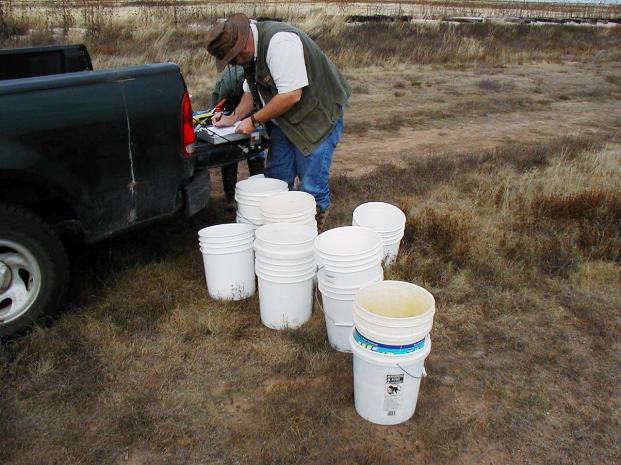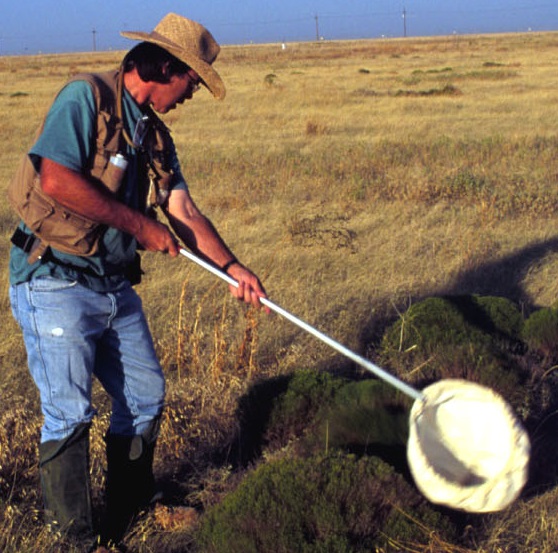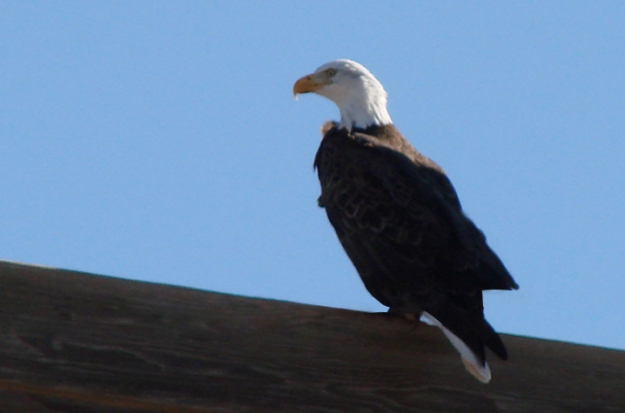Pantex Blog
Wild Pantex – Wildlife Research on the Texas Tech Research Farm
Article by Jim Ray, Pantex Wildlife Biologist/Scientist
The Texas Tech Research Farm is comprised of almost 6,000 acres of land lying between the Pantex Plant and U.S. Highway 60. Operated as a production farm and ranch, the land doubles as a safety and security buffer zone for Pantex.
Wildlife species typical of the High Plains of the Panhandle roam and feed in its prairies and croplands, and waterfowl and shorebirds are fond of two playa wetlands when Mother Nature is gracious enough to provide surface water. Like on the 12,000-acre DOE/NNSA portion of Pantex, during one of my trips across Texas Tech, I may encounter a herd of mule deer, a few white-tailed deer, a bald eagle, or even a bobcat wearing a G.P.S. collar around its neck.
Often, I spot a Texas horned lizard dash off the road ahead of me, and as I stop the vehicle it dives into escape cover on the side of the road. In this case, I locate the lizard, which in Texas, bears a state-threatened status designation. I catch it, and now this lizard will be marked and tracked, becoming one of many from the Texas Tech property to be part of a growing body of wildlife research being conducted there.
Formerly, a host for agricultural research relating to animal science, soils, crops, water conservation, entomology, and range management, little research had occurred on the Texas Tech property for the better part of two decades. Beginning in 2003, research on prairie rattlesnakes begin extending onto Texas Tech from the main Pantex property when a few rattlesnakes being radio-tracked by Pantex and Dr. Richard Kazmaier of West Texas A&M University (WTAMU), made excursions across the boundary between the two properties. My, how things have changed since that time!
Texas Tech Research Farm is now host to several Pantex-sponsored research projects, including work on bobcats, Texas horned lizards, and pre- and post-monitoring of birds in advance of wind energy development. In cooperation with Pantex staff, WTAMU’s Dr. Ray Matlack leads the work related to bobcats and wind energy, and besides work on rattlesnakes, Dr. Kazmaier also led the work on horned lizards. Dr. Clint Boal, USGS Texas Cooperative Fish and Wildlife Unit at Texas Tech University, has joined the collaboration on a portion of the work dealing with birds-of-prey nesting in and near the proposed turbine fields. A considerable amount of research has been performed by Texas Tech wildlife faculty and students at Pantex, but this was all on the adjoining USDOE/NNSA property.
Aside from the value of the information being generated by these studies, it is a great sight to see students, professors and Pantex staff conducting fieldwork across the site, which, depending on the occasion, might include the marking of a horned lizard, setting a trap for a bobcat, applying a radio-transmitter to a Swainson’s hawk, or conducting a survey for grassland birds.
As the name implies, the Texas Tech Research Farm and wildlife research are a great fit. Data from that property adds greatly to the information needs valued by Pantex in the realm of wildlife and habitat management.

Photo: Dr. Richard Kazmaier and buckets full of snakes marked during a Pantex research outing.
Construction on HEPF Project Reaches 85% Mark
Workers at the Pantex High Explosives Pressing Facility this month passed the 85% construction completion mark on construction of the 45,000 square-foot facility, which will combine High Explosives (HE) operations from numerous outdated buildings into one state-of-the-art facility. Completion of the project will help to bolster Pantex’s status as the Department of Energy’s High Explosives Center of Excellence for HE manufacturing.
The roof has been completed, officially enclosing the exterior of the facility, which allows the contractor to continue work inside during inclement weather. The roadway paving around the facility has started, which will allow for all-weather access.
The new state-of-the-art HE presses, which take advantage of advanced isostatic pressing techniques, have been installed. The process equipment has arrived and is being installed. All Blast-Resistant Doors have been installed. Offices have been built and are being painted.
The major remaining work activities include installation of overhead cranes, flooring and mechanical/electrical systems.
Acting NNSA Administrator Bruce Held and NPO Manager Steve Erhart toured the HEPF on November 7th.
Construction of the $65 million facility began in late 2011 and is expected to be complete in May, 2014. B&W Pantex has begun pre start up activities to meet the CD-4 (approval to start operations) date of September 2016.
The construction effort is being managed by the U.S Army Corps of Engineers and the design effort/plant support is being led by B&W Pantex with a design subcontract to CH2M Hill.
Wild Pantex – The Tiniest Pantexans
Article by Jim Ray, Pantex Wildlife Biologist/Scientist
We take them for granted. Bugs, insects, arachnids, mollusks, crustaceans, invertebrates – the little guys.
Me personally – I can walk right up to a hidden rattlesnake that I am radio-tracking and record its location with a GPS Unit. I can let a bobcat out of a trap after we have poked and prodded him.
However, that spider that I am trying to remove from the wall in the kitchen – well, let’s just say that a sudden move by the spider is likely to cause a similar reaction in me.
Macroinvertebrates are the tiniest of the noticeable Pantexans, but they are very important. Some we need because they control each other (spiders, some wasps, and others), some contribute by scavenging or recycling, while most form the foundation of the animal kingdom’s food chain.
Within my role at Pantex, it is just as important to characterize what we have in the way of macroinvertebrates as it is the larger animals. In what was the first of eleven wildlife research projects initiated over the last fourteen years at Pantex, during 2000 – 2001 we contracted with Dr. David Sissom of West Texas A&M University to survey macroinvertebrate diversity among different habitat types at Pantex. These types included shortgrass prairie, shortgrass prairie with prescribed wildlife habitat management, restored prairie, cropland, playa edge, and disturbed/impacted habitat. Some wetland invertebrate work had been performed at Pantex in the past, as had some collections of terrestrial species. However, previous work was limited to few collection techniques and habitats.
The survey documented nearly 900 species of macroinvertebrates, including two state records and a species that has only been recorded one other time in Texas. Shortgrass prairie (both types sampled) and playa edge sites, which were also within shortgrass prairie, were consistently superior in species richness than the other habitat types. The lowest species richness was found in areas kept mowed short, restored prairie sites, and grain sorghum fields, respectively. Restored prairie takes a while to develop plant diversity, and thus to begin to function as prairie habitat.
Species diversity and abundance is a pretty good indication of habitat quality. And some species like songbirds and gamebirds require macroinvertebrates in their diets, particularly their growing offspring. These same birds need the grassland habitat for nesting cover.
In closing, not only did this project produce data for Pantex, it also gave students experience with working in the field, and produced data that has been shared with the scientific community. To date, one technical note and one book has been published from this work. It has also been included in presentations at meetings that summarize Pantex research.

Photo: Dr. David Sissom uses the sweep net technique to catch macroinvertebrates in a shortgrass prairie site at Pantex.
Pantexans Run Against Hunger
Officers run more than 50 miles to raise awareness
For the third year in a row, Pantex Security Police Officers Byron Logan and Randy Stokes took to the area's roads and highways to raise awareness of the hungry in the Texas Panhandle. Logan and Stokes biked and ran and biked more than 50 miles Friday during the annual Run Against Hunger, gathering food and donations for the High Plains Food Bank.


Wild Pantex – Bird of the Day: American Bald Eagle
Article by Jim Ray, Pantex Wildlife Biologist/Scientist
Who doesn’t love bald eagles? My first exposures to them were the several that spent the winters at Lake Rita Blanca near my hometown of Dalhart, TX, when I was growing up. During those months each year of my childhood, it was a big deal to see this majestic bird. They’d be perched in a tree, sitting on the ice, or soaring above the lake. If the latter, the thousands of Rita Blanca’s ducks and geese would whirl around in the sky above the lake with nervousness.
Later, it was my job with the Texas Parks and Wildlife Department to count them each winter as part of my duties as the Migratory Birds and Wetlands Biologist for this region. During ground and aerial surveys, I’d find them often in association with concentrations of waterfowl. The most I ever saw in a small area was ~40 that were congregated near a large waterfowl (ducks and geese) roost numbering near 180,000 birds. There, they were feeding on sick and dead ducks and geese that were victims of the waterfowl disease, avian cholera.
At Pantex, the bald eagle can be readily seen around our playa lakes and our prairie dog colonies during the winter months. Similar to playa lakes providing concentrated sources of waterfowl for them, prairie dog colonies provide prey in the form of prairie dogs, rabbits, and mice and rats; many of which are snatched from smaller, faster birds of prey. In the fall and spring, snakes likely contribute to their diet. You may spy a bald eagle flying overhead, practically anywhere.
Bald eagles nest throughout much of the U.S., but particularly in the north and in the Gulf Coast States. Until recently, the last known nest in the Panhandle was more than 50 years ago. However, a pair has nested in the Dalhart area, annually, over the last several years. Most nests are near water, where the young are fed heavily on fish. However, the Dalhart nest is not associated with water and the U.S.G.S. Cooperative Fish and Wildlife Research Unit at Texas Tech has found that the young are fed primarily on prairie dogs, cottontails, and black-tailed jackrabbits.
Bald eagles get their white head and tail when they are five years old. These contrast greatly with their very dark body plumage. Juveniles are also darker then the golden eagles they may resemble. Keep your eyes peeled – chances are that during the winter months you will have an opportunity to see a bald eagle. I have even seen them flying right over town. Our nation’s symbol is fairly common here; in fact, it is one of the Texas Panhandle’s best kept wildlife secrets.

Photo: A bald eagle perches on a power line pole overlooking the Pantex Waste Water Treatment Facility.
